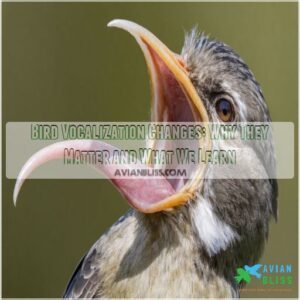This site is supported by our readers. We may earn a commission, at no cost to you, if you purchase through links.

Some species can produce two distinct tones simultaneously using a special organ called the syrinx. Mockingbirds can memorize and mimic over 200 different sounds, while the record-holding lyrebird can imitate chainsaws and camera shutters.
Your backyard cardinal might sing differently than one across town, as birds develop regional "accents." The tiny winter wren belts out notes 16 times faster than opera singers, despite its diminutive size.
What other surprising vocal talents might be hiding in your local birds, with abilities like complex conversations and regional accents that make their songs truly unique?
Table Of Contents
- Key Takeaways
- Bird Vocalization Basics
- Environmental Influence
- Bird Sound Production
- Communication Methods
- Cognitive Abilities
- Conservation Efforts
- Species Specific Sounds
- Cultural Significance
- Frequently Asked Questions (FAQs)
- Why do birds vocalize?
- What is bird vocalization?
- How do Environmental acoustics shape bird vocalizations?
- How many bird vocalizations are there?
- Why do birds make different sounds?
- What do you know about bird sounds?
- How do birds learn to sing?
- Can birds lose their singing ability?
- Do birds vocalize during migration?
- How do weather conditions affect bird calls?
- Conclusion
Key Takeaways
- You’re hearing more than just songs—birds use a specialized organ called the syrinx to produce two distinct tones simultaneously, creating complex communications rather than random noise.
- Your local birds develop regional "accents" just like humans do, with distinct dialects that help them identify members of their own community and distinguish them from outsiders.
- You’ll be amazed by birds’ mimicry abilities—mockingbirds can memorize over 200 different sounds, while lyrebirds can imitate everything from other birds to chainsaws and camera shutters.
- You’re witnessing acoustic adaptation when birds modify their calls—urban birds use higher pitches to cut through city noise, while forest dwellers use lower frequencies that travel better through dense vegetation.
Bird Vocalization Basics
You’ve probably noticed birds singing or chirping, but did you know those sounds are part of a complex communication system.
Bird vocalization includes songs and calls, each serving specific purposes like attracting mates, marking territory, or warning of danger.
Definition of Bird Vocalization
Bird vocalization refers to the sounds birds produce—like songs, calls, and mimicry—to communicate.
Bird vocalization is nature’s symphony—songs, calls, and mimicry creating the soundtrack of our wild world.
These bird sounds are crafted through intricate sound production, showcasing vocal complexity and song diversity.
From sweet melodies to sharp calls, avian communication relies on acoustic features unique to each species.
Bird vocalizations aren’t random; they’re nature’s way of helping birds express themselves and thrive in their environments, utilizing acoustic features to convey their messages.
Importance of Bird Vocalization
Bird vocalization isn’t just noise; it’s nature’s way of staying connected.
From species recognition to social interactions, avian vocalization helps birds communicate, attract mates, and warn of predators.
These songs and calls act as acoustic communication tools and even serve as ecological indicators.
They reveal ecosystem health, offering behavioral insights that scientists use to assess environmental changes and conservation needs, which can be critical for ecosystem health.
Types of Bird Vocalizations
You’ve learned why birds vocalize; now let’s explore their types.
Bird vocalizations include:
- Alarm calls: Short and sharp, they’re like avian security systems.
- Courtship songs: Think of them as romantic ballads luring mates.
- Contact calls: Perfect for flock check-ins.
- Begging calls: Baby birds’ melodramatic cries for food—nature’s built-in drama club!
Each serves specific mimicry functions, reflecting the complexity of bird songs.
Environmental Influence
Bird songs adapt to their surroundings, whether it’s the bustling noise of a city or the quiet stillness of a dense forest.
You’ll notice how habitat, geography, and even body size shape the amazing variety of sounds birds use to communicate, which includes the amazing variety of sounds.
Habitat Effects on Bird Sounds
Where birds live shapes how they sing.
Urban bird songs often run higher-pitched to cut through city noise, while forest acoustics favor lower frequencies for clear signals.
Altitude variations impact sound adaptation, with thinner air making calls carry less.
Even habitat degradation alters avian vocalization, disrupting acoustic signals critical for survival.
It’s like nature’s playlist adjusting to its surroundings!
Geographic Location and Sound Evolution
Geographic location shapes bird vocal evolution in fascinating ways.
Here’s the scoop:
- Regional Dialects: Birds in the same area develop unique “accents,” just like people!
- Latitudinal Variation: Northern and southern birds often sing entirely different tunes.
- Island Endemism: Isolated populations create distinct songs, thanks to geographic isolation.
These regional variations help birds navigate environmental sounds and connect acoustically.
Body Size and Sound Frequency
In the context of bird songs, size really does matter! Large birds like owls use low acoustic frequencies for long-range calls, while tiny finches sing high-pitched tunes to stand out.
It’s all about matching their frequency to their environment—a clever example of Frequency Scaling. Birds also use loud cries to signal danger, but emotional cries can express joy and excitement.
Here’s a quick breakdown:
| Bird Size | Large | Medium | Small | Tiny |
|---|---|---|---|---|
| Vocal Range | Low | Mid-Low | Mid-High | High |
| Sound Frequency | Low-Pitched | Balanced | High-Pitched | Ultrasonic |
| Acoustic Niche | Open Areas | Forests | Woodlands | Dense shrubs |
| Communication Use | Long-Distance | Variety | Recognition | Territory calls |
This breakdown illustrates how birds adapt their vocal range and sound frequency to their environment and needs, showcasing their ability to occupy specific acoustic niches and use their voices for long-distance communication, recognition, and territory calls.
Bird Sound Production
You might be surprised to learn that a bird’s beak isn’t just for eating—it’s a finely tuned acoustic tool.
Along with their size and physical traits, it shapes the pitch, tone, and complexity of the sounds they produce.
Beak Shape and Sound Resonance
A bird’s beak isn’t just for snacking—it’s an acoustic instrument shaping sound frequencies.
Beak morphology, or its size and shape, amplifies or softens vocal tones, much like tuning a guitar.
Different beak shapes adapt to create unique sound characteristics and enhance resonance frequency, giving birds vocal diversity.
It’s incredible how these small adaptations refine their communication, and it’s Fascinating, right?
Physical Attributes and Vocal Diversity
Think of beak morphology and body size as nature’s soundboard. A bird’s syrinx anatomy and beak shape work together like a finely tuned instrument, creating a diverse vocal repertoire.
Here’s how:
- Larger birds use resonance for low-pitched calls.
- Smaller ones rely on frequency variation for clarity.
- Curved beaks amplify melodies.
- Syrinx complexity boosts vocal options.
- Broad beaks enhance bird songs’ volume.
The combination of these factors allows birds to produce a wide range of sounds, from simple calls to complex bird songs.
Frequency Range and Vocal Complexity
Moving from how physical traits shape bird vocalization, let’s talk pitch and size. Smaller birds use higher sound frequencies, while larger ones favor deeper tones.
Habitat acoustics influence frequency use—think clearer songs in open fields versus muffled forest calls. Some species utilize vocal learning for complex vocalizations, creating song diversity.
Here’s a quick breakdown:
| Factor | Frequency Effect | Example |
|---|---|---|
| Body Size | Small = High Pitch | Warbler’s chirps |
| Habitat Acoustics | Dense = Lower Frequency | Owl’s soft hoots |
| Vocal Learning | High Complexity | Mockingbird’s mimicry |
Communication Methods
When birds communicate, they use songs, calls, and even mimicry to send messages that can mean survival or connection.
Their sounds aren’t random—they’re strategic, covering everything from warning predators to attracting mates.
Songs and Calls for Survival
In the wild, vocal communication isn’t just chatter—it’s survival.
Bird calls warn of lurking predators, alerting flocks to scatter.
Songs help with mate attraction, showing fitness like a feathered serenade.
Flock coordination keeps birds together during chaotic flights.
Even food announcements guide hungry friends.
These survival strategies highlight how essential bird calls are for predation defense, territorial defense, and thriving communities.
Territorial Warnings and Mate Attraction
Bird vocalizations often serve two major purposes: territorial defense and mating.
Males create complex songs to claim territories and attract mates, impressing females with their vocal skills.
Sometimes, pairs use duetting behavior to strengthen their bond.
Vocal dialects and mimicry functions can also reflect local environments, making bird calls useful tools for communication and competition.
It’s nature’s ultimate karaoke showdown!
Vocal Learning and Mimicry
Some birds, like parrots and mockingbirds, are masters of mimicry, showcasing vocal learning that mirrors human language acquisition.
Their mimicry variations serve purposes like territorial defense and attracting mates.
Brain structures enable them to imitate sounds with precision, creating vocal dialects.
This bird vocal repertoire relies on auditory discrimination, highlighting parallels between avian vocal learning and human communication skills—impressive and endlessly fascinating!
Cognitive Abilities
You’d be amazed at how smart birds are in regard to their vocal skills.
Their brains help them mimic sounds, solve problems, and even adapt songs for communication that rivals human creativity, showcasing their vocal skills.
Brain Size and Vocal Complexity
Cognition and songs go hand in hand with brain size and vocal innovation.
Birds with larger brains show exceptional vocal learning and song complexity. Their brain structure links to mimicry extent and problem-solving skills.
Think parrots, starlings, and crows—masters of complex vocalizations.
It’s like nature made tiny composers who combine intelligence and creativity in their chirps!
Auditory Processing Skills
Recognizing sounds isn’t just for humans. Birds showcase advanced auditory processing skills, like identifying familiar calls or novel sounds. Their brain structures let them master sound discrimination with remarkable precision, enhancing vocal learning and communication. Think of it as their built-in sound lab!
To further refine these skills, birds often rely on habitat soundscapes for vital environmental cues.
| Skill | Function | Example | Benefit | Importance |
|---|---|---|---|---|
| Sound discrimination | Detect call differences | Species identification | Avoids miscommunication | Supports survival |
| Novel sound recognition | Analyze new sounds | Alarm calls | Adapts to changing environments | Thrives in varied settings |
| Vocal learning | Mimic tunes accurately | Song development | Attracts mates | Maintains social bonds |
| Mimicry analysis | Differentiate mimicry | Hawk-like calls | Confuses predators | Guards territories |
| Brain structure use | Process audio signals | Complex songs | Enhances communication skills | Strengthens ecosystems |
The table highlights the importance of sound in a bird’s life, from species identification to thriving in varied settings. It showcases how advanced auditory processing skills are crucial for survival and social bonds. By mastering sound discrimination and vocal learning, birds can attract mates, guard territories, and strengthen ecosystems.
Mimicry and Auditory Memory
Imagine a bird impersonating a car alarm—pretty wild, right?
Mimicry birds like lyrebirds and mockingbirds master sound imitation with remarkable memory capacity.
This advanced vocal learning isn’t just for show; it serves purposes like territorial defense and mate attraction.
Mimicry evolution highlights their auditory processing brilliance, transforming random noises into communication tools.
Bird mimicry proves nature’s creativity knows no bounds.
Conservation Efforts
You can help protect birds by paying attention to their sounds, as changes in vocal activity often signal environmental shifts.
By recording and sharing bird songs, you’re contributing valuable data to conservation efforts and ecosystem research, which can be a crucial part of conservation efforts.
Acoustic Monitoring and Ecosystem Health
Tracking bird songs isn’t just fascinating—it’s smart science. Acoustic monitoring uses animal sounds to assess ecosystem health, offering insights into population assessments and habitat degradation.
Think of it as Google for nature’s melodies. Soundscape analysis reveals acoustic biodiversity, aiding conservation planning by decoding threats.
This acoustic ecology tool turns chirps and calls into vital data for protecting wildlife and ecosystems. Bird populations serve as indicators of ecosystem health, which is a crucial aspect of ecosystem health.
Soundscapes and Environmental Changes
Soundscapes offer a unique window into environmental change, revealing acoustic biodiversity and shifts in bird populations.
By analyzing these acoustic landscapes, you can spot signs of habitat degradation and monitor populations over time.
Whether it’s a missing call or reduced acoustic diversity, soundscape analysis helps conservation planning by highlighting changes in environmental conditions, making it a powerful tool for protecting ecosystems.
Citizen Science Contributions
You’re helping conservation efforts every time you join a citizen science project.
Through data collection programs like sound recording and volunteer-driven platforms, you’re contributing to population assessments and habitat restoration.
Your recordings create valuable conservation data for global analysis, revealing changes in ecosystems.
Using a specialized recording device can improve data collection.
Plus, knowing your birdwatching hobby has a conservation impact? That’s like icing on the ecological cake!
Species Specific Sounds
When you listen closely, you’ll notice each bird species has its own signature sound, like a name tag made of music.
These unique calls and songs help them communicate, attract mates, and even stand out in a noisy world.
Nightingales and Nocturnal Serenades
Nightingales captivate with their nocturnal performances, showcasing impressive Nocturnal Song Complexity during the breeding season.
These melodies serve as both territorial claims and intricate Nightingale Breeding Rituals. Factors like Melodic Variation, shaped by habitat and evolution, make each song unique.
Sadly, Urban Nightingale Decline highlights challenges for this master of bird vocalization, whose unforgettable songs symbolize nature’s unmatched beauty and adaptability.
Unique Vocalizations of Owls and Loons
Owls whisper through the night with an eerie mix of hoots and screeches, perfected for their nocturnal sounds.
Their acoustic characteristics let them call to mates or defend territories quietly.
Loons, on the other hand, enchant with waterbird acoustics—haunting wails and yodels that echo across lakes.
These unique bird vocalizations capture the mysterious beauty of the wilderness, with sounds that are both haunting and enchanting.
Hummingbirds and Penguins
Hummingbird communication features high-pitched chirps and whistles, perfect for species recognition and mating rituals.
Penguins, masters of colony acoustics, rely on unique vocalizations, like the African Penguin’s braying.
While hummingbirds are famous for their agility, Penguins impress with their mating calls amidst chaotic, noisy colonies.
These avian vocalizations showcase how frequency and purpose adapt to each bird’s lifestyle and survival needs.
Some species even use songs for territorial defense, which is crucial for their survival needs.
Cultural Significance
You mightn’t realize it, but bird songs have shaped cultures, inspiring everything from ancient folklore to modern music.
Regional sounds add unique flavors, turning each bird call into a chorus of local history and meaning.
Symbolism of Bird Sounds in Folklore
Bird vocalization holds deep symbolism in folklore across cultures.
Songs like the whip-poor-will’s haunting melody often symbolize omens or solitude.
Cuckoos’ calls herald spring, while ravens are tied to prophecy.
Ancient tales even feature bird-sound deities linked with wisdom or fate.
These folklore interpretations reveal how melodies inspire tales that intertwine nature, humanity, and cultural myths.
Inspiration for Poets and Musicians
From Shakespeare to folk ballads, birds have charmed poets and musicians with their melodies.
Nightingales influence tales of love, while ravens spark mystery in literature.
Robins symbolize hope with cheerful tunes, and kookaburras evoke laughter at dawn.
Canaries even inspired freedom anthems.
Their songs, filled with symbolism, connect art and nature, proving how music can soar beyond words.
Regional Differences in Bird Sounds
Just as poets find different muses, birds develop distinct regional "accents."
You’ll notice white-crowned sparrows in the Bay Area sing differently than their Puget Sound cousins.
These vocal dialects emerge through geographic isolation and acoustic adaptation to local soundscapes.
Urban birds typically use higher pitches to overcome city noise, while rural relatives maintain lower, more leisurely songs.
Female birds even use these regional differences to identify local males from outsiders, utilizing regional differences and acoustic adaptation.
Frequently Asked Questions (FAQs)
Why do birds vocalize?
You’ll hear birds vocalize to attract mates, defend territory, warn of predators, maintain contact with family, and express emotions.
Their songs and calls serve as sophisticated communication tools essential for survival.
What is bird vocalization?
You’re hearing nature’s symphony when birds vocalize.
It’s their way of communicating through calls, songs, and sounds they produce to attract mates, defend territory, warn of predators, and maintain social bonds, which can be considered their way of communicating.
How do Environmental acoustics shape bird vocalizations?
Like an orchestra adapting to its concert hall, birds modify their songs based on their environment.
You’ll notice they’ll use higher frequencies in cities and lower ones in forests to overcome acoustic challenges.
How many bird vocalizations are there?
You’ll find staggering diversity in bird vocalizations.
Scientists have analyzed over 140,000 recordings, with some species like brown thrashers producing more than 2,000 distinct song types.
While many birds also use 16+ different call categories.
Why do birds make different sounds?
Birds make different sounds for territory defense, attracting mates, warning of danger, and communicating with their flock.
Their physical characteristics like body size and beak shape also determine the sounds they’ll produce, which is crucial for territory defense.
What do you know about bird sounds?
You’ll find that bird sounds serve many functions – from attracting mates to warning of predators.
They’re influenced by factors like habitat, beak shape, and body size, creating nature’s most diverse acoustic library.
How do birds learn to sing?
Many birds learn to sing through a process called vocal learning.
You’ll notice they listen to adults, practice extensively, and develop their own vocal style, similar to how you’d learn an instrument.
Can birds lose their singing ability?
Just as a melody can fade with time, birds can lose their singing ability due to aging, illness, injury, or environmental stress.
You’ll notice their songs becoming less complex or disappearing completely.
Do birds vocalize during migration?
Yes, you’ll hear them chatting during their travels.
Many species produce "nocturnal flight calls" – short, high-frequency sounds that help with navigation, especially over bright cities.
These airborne conversations might even facilitate information exchange between different species.
How do weather conditions affect bird calls?
Weather dramatically shapes how you’ll hear birds calling. Rain muffles sounds, wind forces louder calls, and temperature changes alter sound travel—cold air carries calls farther than warm air does.
Conclusion
Have you ever considered the symphony occurring just outside your window?
From their dual-toned syrinx to regional dialects and chainsaw impressions, cool facts on bird vocalization reveal nature’s most sophisticated sound system.
You’re not just hearing noise—you’re witnessing complex communications developed over millennia.
Next time you hear chirping, listen closely.
You’ll gain new appreciation for these feathered musicians and their remarkable vocal abilities.
The conversation happening in your backyard is more intricate than you imagined.















